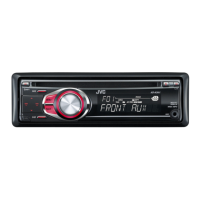
Do you have a question about the JVC KD-R303 and is the answer not in the manual?
| Brand | JVC |
|---|---|
| Model | KD-R303 |
| Category | Car Receiver |
| Language | English |
Important warnings and cautions regarding Class 1 laser products, emphasizing not opening the unit.
Safety warnings related to operating the unit while driving and setting appropriate volume levels.
Guidance on operating in extreme temperatures and proper disposal of old equipment and batteries.
Instructions for resetting the unit, noting that presets will be erased.
Steps to forcibly eject a disc if normal ejection fails.
Procedures for removing and reattaching the detachable control panel.
Explanation of the unit's buttons, controls, and their basic operations.
Detailed explanation of various indicators and symbols shown on the unit's display.
Steps to cancel the display demonstration and set the unit's clock time.
How the display information cycles through different settings like frequency, clock, and text.
Methods for searching and tuning into radio stations using auto or manual search.
Instructions for automatically and manually presetting radio stations for quick access.
How to improve FM reception by switching to mono sound.
How to select a previously stored preset radio station.
Activating and deactivating Traffic Announcement standby reception.
Tuning into programs by searching for specific PTY (Programme Type) codes.
Activating and deactivating PTY standby reception for favorite programs.
How the unit automatically tunes to stronger signals for the same program network.
Activating programme search and a list of available PTY codes.
Steps for turning on the unit, inserting, playing, and ejecting discs.
How to prohibit disc ejection and how to cancel the prohibition.
How to select tracks and folders for MP3/WMA discs using the control dial.
Options for repeating tracks/folders or playing tracks in random order.
Instructions for connecting and operating external audio components via the AUX input.
How to select preset sound modes like Rock, Classic, Pop, etc.
Steps to create and store custom sound settings (USER mode) by adjusting Bass and Treble.
How to manage display demonstration, clock display, and time settings via the menu.
Adjusting display/button dimmer and configuring scroll behavior for displayed information.
Configuring alternative frequency reception, PTY standby, and monaural mode for tuning.
Activating programme search and selecting display/button illumination colors.
Adjusting speaker balance (fader/balance) and loudness settings for audio output.
Configuring auxiliary input level, telephone muting, and amplifier gain control.
Enabling or disabling AM and AUX input sources for selection.
Guide to creating personalized "DAY COLOR" and "NIGHT COLOR" settings for the display and buttons.
Further details on turning the unit on/off, source changes, and general operation tips.
Advanced information on storing stations, RDS operations, and disc handling cautions.
Information on playing CD-R/RW discs, including compatibility and reasons for failure.
Specifications and conditions for MP3/WMA files, including bit rate and supported formats.
Details on disc formats, file/folder name limits, and unsupported file types.
Solutions for common issues like no sound, unit not working, or AUX IN selection problems.
Remedies for static noise, SSM presetting problems, and AM selection issues.
Solutions for disc playback errors, interrupted sound, and display messages like "NO DISC".
Troubleshooting steps for MP3/WMA playback issues like noise, long readout times, or character display problems.
Instructions for cleaning the unit's connectors and keeping discs clean to ensure proper operation.
Advice on dealing with moisture, proper disc handling, storage, and unplayable disc types.
Technical specifications for the audio amplifier section, including power output and frequency response.
Technical details of the FM, MW, and LW tuners, including frequency range and sensitivity.
Technical specifications for the CD player, including decoding formats and bit rates.
General technical specifications such as power requirements, dimensions, and operating temperature.
A reminder to reset the unit when experiencing operational problems.
